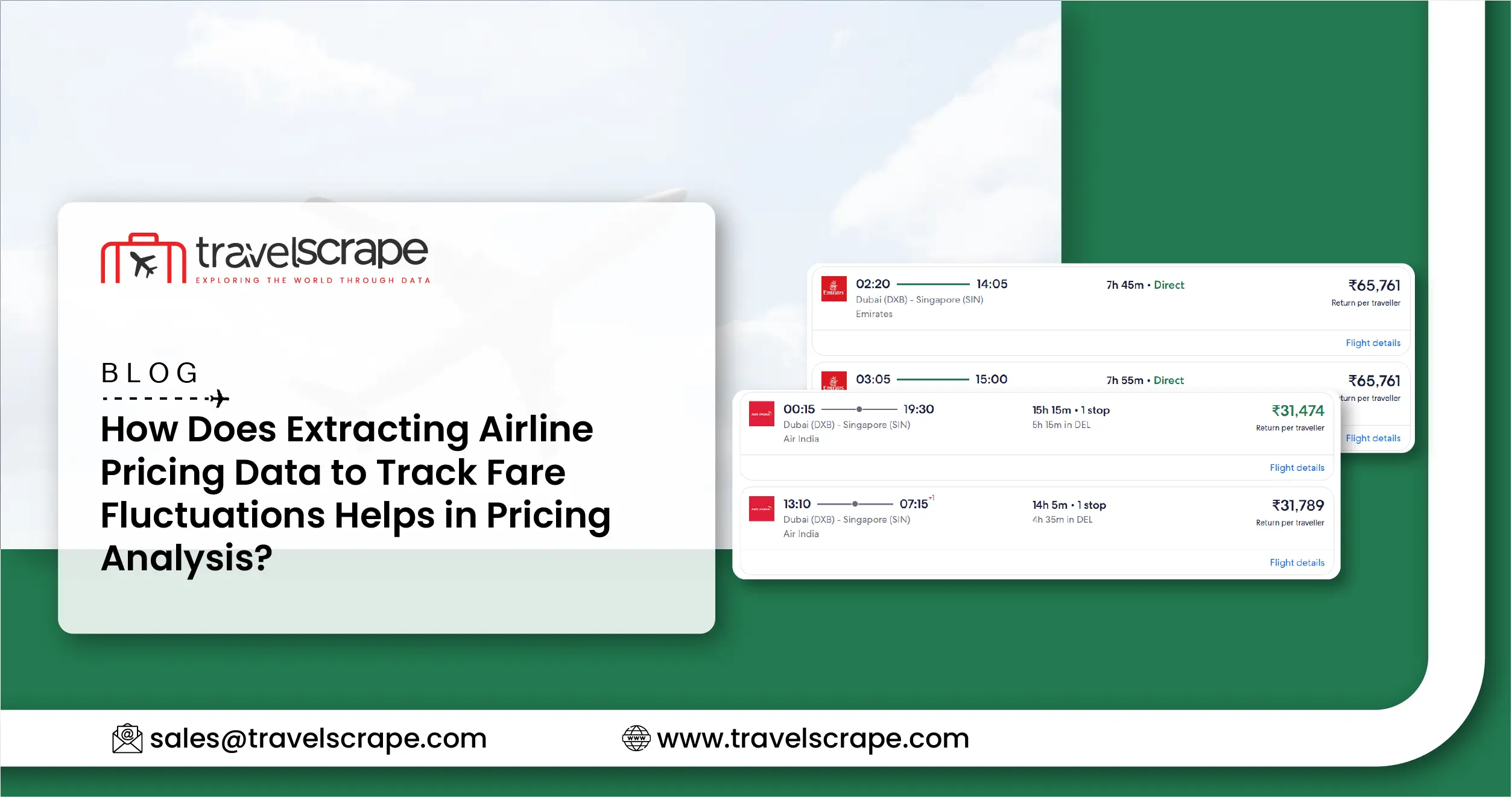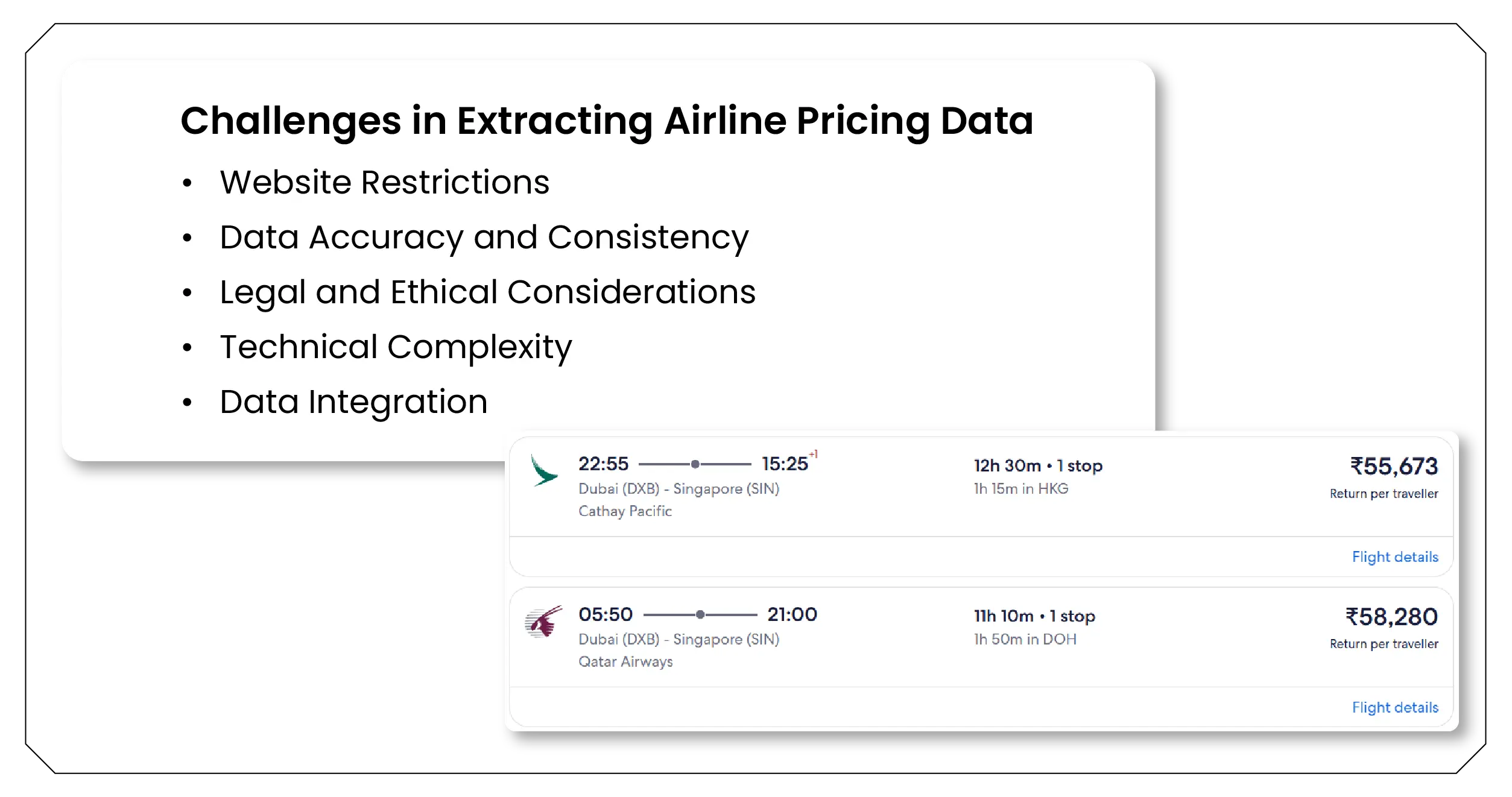How Does Extracting Airline Pricing Data to Track Fare Fluctuations Helps in Pricing Analysis?

Introduction
In today’s highly competitive travel industry, monitoring airfare changes has become crucial for airlines, travel agencies, and travelers alike. Extracting Airline Pricing Data to Track Fare Fluctuations provides valuable insights into market dynamics, enabling stakeholders to make informed decisions. By analyzing flight price patterns, companies can optimize their offerings, adjust pricing strategies, and predict future trends with remarkable accuracy. One of the most comprehensive sources for such data is the Skyscanner Global Flight Prices Dataset , which aggregates millions of flight fares from around the world to deliver a holistic view of the market.
Airline pricing is highly dynamic, influenced by factors like seasonal demand, holidays, special events, and even real-time booking behaviors. Traditional methods of monitoring fares manually are not only time-consuming but often ineffective due to the speed at which prices can change. Advanced data extraction techniques allow for continuous surveillance of airline fares, ensuring that travel companies can respond swiftly to market fluctuations. For example, platforms that Scrape Swiss Airlines Data for Fare Change Analysis can identify sudden dips or spikes in ticket prices, helping agencies create competitive offers.
The Importance of Tracking Fare Fluctuations
Understanding fare fluctuations is critical for several reasons. Airlines need to balance supply and demand while maximizing revenue, and travel agencies require accurate pricing data to attract customers with competitive offers. Travelers also benefit from real-time insights, enabling them to book flights at the most opportune moments. With data-driven intelligence, companies can predict periods of high demand, plan promotional campaigns, and optimize their revenue management strategies. This approach allows businesses to remain agile in a market that is increasingly dependent on technology and real-time information.
Extracting fare data involves capturing various parameters such as flight routes, departure and arrival times, ticket class, and seasonal trends. By consolidating these data points, analysts can generate actionable insights that inform pricing strategies. Tools designed to extract Skyscanner flight price data a streamline this process, transforming vast amounts of raw information into structured datasets suitable for detailed analysis.
Methods of Airline Data Collection
There are several methods for collecting airline pricing data, ranging from API integration to web scraping techniques. APIs provided by airlines or aggregators offer structured data that is easy to process. However, these often come with limitations such as restricted endpoints or delayed updates. On the other hand, web scraping allows for more flexible data extraction from multiple sources, including airline websites and flight comparison platforms. Techniques used to extract Skyscanner airline fare trends for the travel market can aggregate data across multiple dates and routes, ensuring comprehensive coverage.
Web scraping has emerged as a preferred approach due to its versatility and scalability. It enables organizations to collect data from various airline portals, analyze pricing patterns, and generate reports that can inform strategic decisions. Advanced scraping solutions not only extract prices but also track ancillary charges, seasonal offers, and competitor pricing, providing a multidimensional view of the market.
Leveraging Technology for Real-Time Insights
Real-time monitoring of airline fares has become a necessity in the digital age. Fare changes can occur within minutes due to shifts in demand or competitor pricing. Organizations that implement Airline Data Scraping Services gain a competitive edge by accessing up-to-the-minute information, which can be used to adjust marketing strategies, recommend optimal booking windows, and forecast future trends.
The integration of machine learning algorithms with fare data further enhances predictive capabilities. Historical pricing data, when combined with real-time monitoring, allows for the identification of patterns and anomalies. This enables airlines and travel platforms to anticipate fluctuations, optimize revenue management, and enhance customer experience. Tools designed for web scraping Skyscanner flight prices for travel intelligence can automate the entire workflow, from data collection to analysis, saving both time and resources.
Benefits for Airlines and Travel Agencies
The benefits of systematic airfare data extraction are immense. Airlines can implement dynamic pricing strategies that maximize revenue while remaining competitive. Travel agencies and online booking platforms can provide better deals to customers by leveraging comprehensive datasets. Accurate, real-time information also facilitates targeted marketing campaigns, personalized offers, and loyalty program optimization.
By tracking fare changes with precision, companies can reduce missed opportunities and improve forecasting. For example, real-time Swiss Airlines flight price tracking using data scraping allows agencies to monitor ticket prices for specific routes and adjust their offerings immediately. This capability can significantly improve conversion rates and customer satisfaction.
Applications in Market Analysis
Fare data extraction is not limited to operational advantages; it also serves as a powerful tool for market research and competitive analysis. Understanding how prices fluctuate across airlines and routes provides a clear picture of market behavior. Analysts can study trends, compare competitor pricing, and evaluate the impact of external factors such as fuel prices, geopolitical events, or tourism trends.
Platforms leveraging Global Flight Price Trends Dataset can offer insights into long-term trends, helping stakeholders make strategic decisions. For example, identifying routes that consistently show price volatility can guide airlines in adjusting capacity, optimizing schedules, or offering promotional discounts to stimulate demand.
Key Applications of Airline Fare Data
- Revenue Optimization: Airlines can adjust pricing dynamically based on market conditions to maximize revenue.
- Competitive Benchmarking: Travel agencies can track competitors’ fares to maintain competitive offers.
- Market Research: Analysts can study fare fluctuations across regions, routes, and seasons to identify opportunities.
- Forecasting and Trend Analysis: Historical and real-time data enables predictive modeling of future fare trends.
- Personalized Travel Recommendations: Platforms can provide customers with alerts, suggestions, and booking guidance based on fare insights.
By leveraging these applications through solutions like web scraping Skyscanner flight prices for travel intelligence, organizations can make data-driven decisions and stay ahead in the competitive travel market.
Challenges in Extracting Airline Pricing Data

Despite its advantages, airline pricing data extraction comes with challenges. Websites often implement measures to prevent automated scraping, such as CAPTCHA systems, IP restrictions, or dynamic content loading. Maintaining the accuracy and consistency of data across multiple sources is also a complex task. Moreover, understanding the legal and ethical considerations surrounding data collection is essential to ensure compliance with regulations and avoid potential disputes.
- Website Restrictions: Many airline and aggregator websites use CAPTCHA, IP blocking, or dynamic content to prevent automated scraping.
- Data Accuracy and Consistency: Prices can change rapidly, and maintaining accurate and consistent data across multiple sources is complex.
- Legal and Ethical Considerations: Collecting data from websites must comply with legal regulations, terms of service, and privacy policies to avoid disputes.
- Technical Complexity: Implementing scalable, real-time scraping solutions requires advanced technical expertise and robust infrastructure.
- Data Integration: Combining data from multiple airlines, routes, and dates into structured datasets can be challenging.
To overcome these challenges, companies utilize advanced scraping frameworks, rotating IP addresses, and structured parsing methods. By adopting a systematic approach, organizations can ensure reliable and comprehensive data collection.
Key Features of Effective Data Extraction
Effective airline pricing data extraction involves several key features:
- Scalability: Ability to handle large volumes of data across multiple airlines and routes.
- Accuracy: Ensuring that the data collected reflects the actual prices and conditions.
- Automation: Minimizing manual intervention to enable continuous monitoring.
- Real-Time Updates: Capturing fare changes as they happen to inform timely decisions.
- Data Structuring: Organizing raw data into structured formats suitable for analysis.
Solutions designed to extract Skyscanner flight price data or implement real-time Swiss Airlines fare tracking focus on these features to deliver maximum value.
Predictive Analytics and Forecasting
One of the most exciting applications of fare data extraction is predictive analytics. Historical fare patterns, combined with real-time updates, allow airlines and agencies to forecast future price trends. These insights can guide strategic planning, promotional campaigns, and inventory management. For instance, advanced forecasting models can predict periods of high demand, helping airlines adjust capacity and optimize pricing.
By utilizing tools to extract Skyscanner airline fare trends for the travel market, businesses can anticipate customer behavior, identify optimal booking windows, and design loyalty incentives tailored to traveler preferences. This proactive approach significantly improves decision-making and enhances profitability.
Enhancing Customer Experience
Fare data extraction also has a direct impact on the customer experience. Real-time information allows travel platforms to offer the most competitive prices, personalized recommendations, and timely alerts about price drops. Customers benefit from transparency and convenience, making them more likely to return to platforms that provide accurate and up-to-date fare information.
Travel agencies that implement Airline Data Scraping Services can create dashboards and alerts that notify users of fare changes, enabling travelers to book at the best possible rates. This not only builds trust but also strengthens customer loyalty over time.
Industry Use Cases
- Revenue Management: Airlines can optimize ticket pricing and promotions based on dynamic market data.
- Competitive Benchmarking: Travel agencies can track competitors’ fares and adjust offers accordingly.
- Market Research: Analysts can study trends across regions, seasons, and flight routes to identify growth opportunities.
- Travel Recommendations: Platforms can offer personalized travel suggestions based on fare trends and user preferences.
Using web scraping Skyscanner flight prices for travel intelligence, businesses can operationalize these use cases efficiently and effectively.
Future Trends in Airline Fare Analytics

As technology continues to evolve, fare monitoring and extraction are expected to become even more sophisticated. Artificial intelligence and machine learning models will enhance predictive accuracy, while automation and cloud-based solutions will enable faster and more scalable data collection. Real-time dashboards and visualization tools will allow decision-makers to interact with data intuitively, improving both operational and strategic planning.
Additionally, the integration of external datasets, such as tourism statistics, weather forecasts, and geopolitical indicators, will provide a multidimensional view of the market. This comprehensive approach will enable stakeholders to anticipate shifts in demand and respond proactively, staying ahead in an increasingly competitive industry.
How Travel Scrape Can Help You?
- Automated and Scalable Data Collection: Our data scraping services use advanced tools like Scrapy, Selenium, or API integrations to efficiently gather flight price data from multiple sources (e.g., airline websites, OTAs like Expedia or Kayak) at scale, saving time and ensuring comprehensive coverage of routes, dates, and airlines.
- Customized Data Extraction: We tailor scraping solutions to your needs, extracting specific data points like flight prices, departure/arrival times, layovers, or airline details. Our services ensure accurate and structured data delivery in formats like CSV, JSON, or databases for seamless integration into your systems.
- Real-Time and Scheduled Updates: Our services provide real-time or scheduled scraping to capture dynamic flight price changes, enabling you to monitor trends, identify deals, or power applications like fare alerts or price comparison tools with up-to-date data.
- Compliance and Ethical Scraping: We adhere to legal and ethical standards by respecting website terms of service, using rate-limiting to avoid server overload, and leveraging official APIs where available, minimizing risks while ensuring reliable data collection.
- Data Cleaning and Analysis Support: Our services include data cleaning to handle inconsistencies (e.g., currency formats, missing fields) and deliver structured, analysis-ready datasets. We can integrate with tools like Pandas or databases to help you derive insights, such as price trends or optimal booking times.
Conclusion
In conclusion, the ability to track airfare changes through systematic data extraction is a game-changer for the travel industry. Organizations leveraging extract Swiss Airlines and Skyscanner data for fare tracking can gain actionable insights that enhance pricing strategies, improve customer experience, and optimize revenue management.
By focusing on scraping flight fare changes from Swiss Airlines and Skyscanner, stakeholders can monitor real-time trends, forecast future pricing, and conduct competitive benchmarking. The implementation of Flight Price Data Intelligence transforms raw fare information into a powerful tool for decision-making, driving efficiency and profitability in a dynamic market.
The integration of advanced scraping technologies, predictive analytics, and structured datasets ensures that airlines and travel agencies are well-equipped to navigate the complexities of modern airfare dynamics. As the industry continues to evolve, leveraging pricing data strategically will remain a critical component of success.
Italy’s complex train network requires precise, real-time insights for effective route optimization. Travel agencies, tour operators, and planners can significantly benefit from structured, automated data collection. Extract train route data from Trenitalia for travel agencies, using insights gained to enhance service quality, anticipate demand, and improve revenue management. Leveraging Italian train route optimization Trenitalia data scraping along with Travel Review Analysis allows businesses to align offerings with customer expectations and maintain a competitive advantage. Data-driven route optimization is now indispensable in Italy’s travel landscape.
Ready to elevate your travel business with cutting-edge data insights? Scrape Aggregated Flight Fares to identify competitive rates and optimize your revenue strategies efficiently. Discover emerging opportunities with tools to Extract Travel Website Data, leveraging comprehensive data to forecast market shifts and enhance your service offerings. Real-Time Travel App Data Scraping Services helps stay ahead of competitors, gaining instant insights into bookings, promotions, and customer behavior across multiple platforms. Get in touch with Travel Scrape today to explore how our end-to-end data solutions can uncover new revenue streams, enhance your offerings, and strengthen your competitive edge in the travel market.